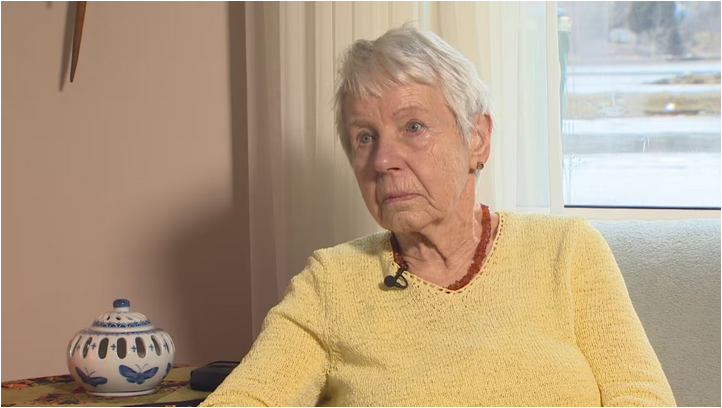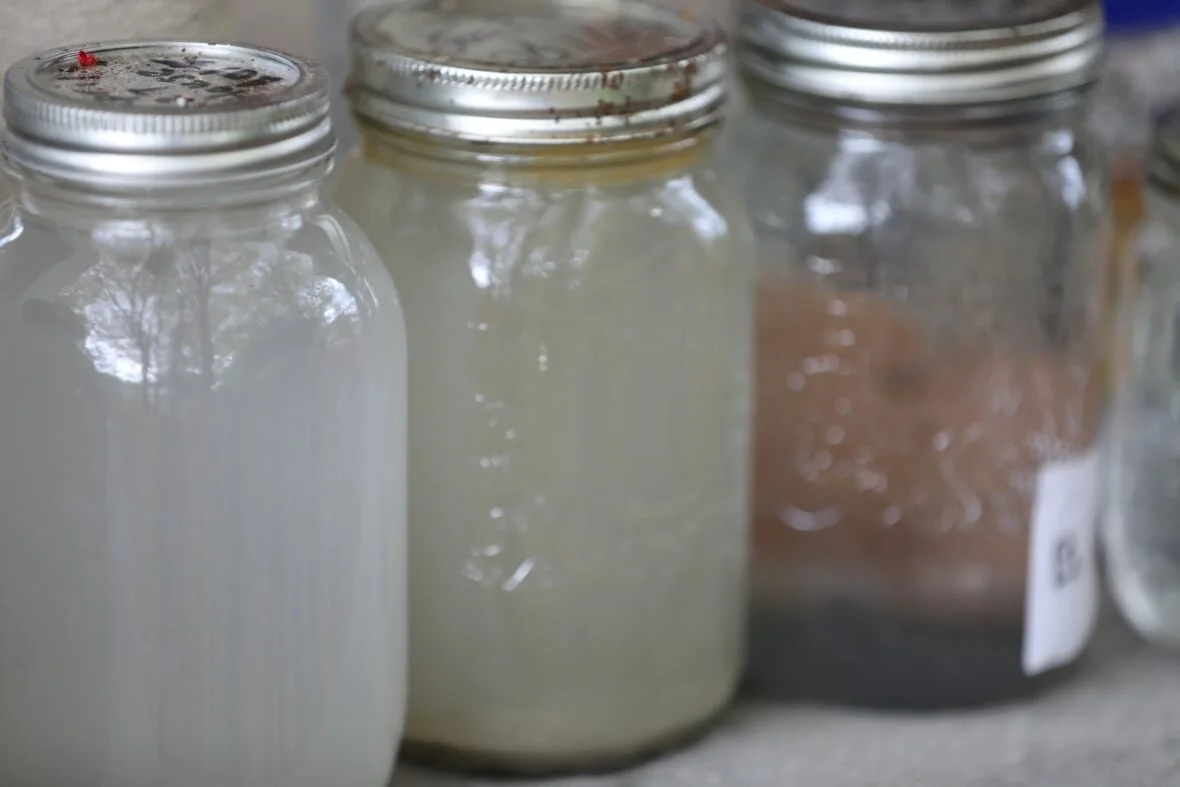For example, some people may not be able to afford tests needed to identify cancer-causing factors like radon exposure or arsenic in well water. Others may not be able to pay for measures needed to reduce or eliminate those risks after they've been identified, Rigby said.
Saskatchewan landowners say illegal drainage is washing out land, roads downstream
Brent Fry, who farms grain and livestock, said it's common for his land to flood for three days when people upstream get 50 millimetres of rain. He said it has caused roads and access points to erode. "There are about four farms out there and all they're doing is draining whether they've got permission or not," Fry said. "I don't even know what to do because the government's not doing anything — they're siding with the big guys."
'There's no accountability': Tantallon property contaminated, but no one will clean it up
Brink said at the time, her family made a few calls to find out what could be done, including to the Environment Department, but nothing much came of it. They tested their well water and the results showed it was safe. It wasn't until last year that Brink's daughter, Margret Holland, received the results of a freedom of information request and learned that the commercial property and her mother's property are contaminated with total petroleum hydrocarbons, including benzene, toluene, ethylbenzene and xylene.
Here's how to reduce the risk of cancer if you have arsenic in your well water
A Memorial University researcher is urging well owners in Newfoundland to make lifestyle changes to reduce the risk of disease caused by arsenic exposure. Atanu Sarkar, an assistant professor in the Faculty of Medicine, says years or decades of drinking water contaminated by arsenic increases the risk of several cancers — including kidney, liver and lung cancer — due to epigenetic changes that occur during long-term exposure. "They're more prone to have cancer in [the] future," Sarkar said.
Arsenic levels in Garden Bay well water under investigation, residents notified four weeks later
The water supplied to 18 Garden Bay area homes is under a “do not use” warning from Vancouver Coastal Health (VCH) as of Nov. 4. Dream Valley Estates residents were notified by VCH that slightly elevated arsenic levels were detected in Sept. 28 water supply samples. Health Canada’s maximum acceptable concentration (MAC) for arsenic in drinking water is 10 parts per billion (ppb). Two of three Dream Valley samples tested at 11.3 and 11.6 ppb. One of those samples tested raw water and one was on treated water.
Residents concerned water treatment plant in Beausejour, Man., will impact Brokenhead River
Concerns are rising as work begins on a water treatment plant in Beausejour, Man., prompting some residents to challenge government officials over potential impacts on the Brokenhead River. The new facility in the east end of the town will treat well water using reverse osmosis. A pipe is being installed along Park Avenue to send the filtered well water the system rejects into the Brokenhead River, raising questions on how that might affect water quality and wildlife.
Important health, well water, waste disposal and road closure information in response to storm
Well water Well water can become contaminated after extreme weather and flooding. Ensure your well water is safe during and after emergencies on the Government of Canada’s Be Well Aware page. General well water information Residents with private wells can get more information about well water maintenance and safety on the Durham Region Health Department’s Private wells page.
Residents fear effects of increasing quarry activity on Elmvale groundwater, believed to be cleanest in world
Pauzé says she started noticing changes in her well water when a nearby quarry, now operated by the Dufferin Aggregates division of CRH Canada, started drawing millions of litres of groundwater most days to wash gravel in 2009. The quarry is located on the northern edge of French's Hill, a groundwater recharge area where rainfall enters the ground and replenishes the regional water flow system. Owners of at least a dozen wells situated downgradient of the Teedon Pit and its aggregate washing operations have complained of changes in their water, and they suspect wash water is leaking into the underlying groundwater flow system.
Construction contaminates well water in area near Montfort Hospital, residents say
If the developer's proposal is approved, residents say they're worried the required deep drilling and excavation could leave their water undrinkable. It's a problem homeowners said they've watched emerge over decades of routine testing. "We seem to be in a kind of Groundhog Day scenario as each development comes up," said Al Crosby, who has lived in Fairhaven since 1978.
Is your well doing well? Water well, that is.
With many residents of Woodlands County utilizing well water, the municipality hosted a virtual workshop on October 21 on managing wells. The event streamed live and enabled attendees to ask questions in real-time. Multiple specialists were on hand, including Jeff Hammer, a Public Health Inspector for Alberta Health Services. Hammer discussed the importance of testing water and why it’s essential to do so. “We have two types of tests available at the health units. One is a bacteriological bottle which we test for total Coliform and E. coli. Total Coliform is an indicator of bacteria, and E. coli is basically fecal matter which you never want to see. The other type of test we have is a chemical water sample. It does a bunch of minerals and metals and has some more health parameters associated with it.” Hammer said that some of the minerals and metals tested for include manganese, lead, arsenic, and the pH value of the water.
Well water fears prompt calls to halt proposed bottling plant near B.C. village
Angie Kane knows how important well water is when you live in the heart of dry, rural B.C. For 17 years, she lived on a ranch outside Clinton, a semi-desert village about 120 kilometres northwest of Kamloops. Many residents who live outside municipal boundaries draw water from aquifers. For Kane, the arid climate always kept the importance of her water supply top of mind. "That is the biggest concern, for anyone who has a well, is will it dry up? Or will it go away?" she told CBC News.
After decades of legal battles, residents of Shannon, Que., set to be compensated for contaminated water
Stephan Gurgurewicz, a self-described army brat who grew up at the Canadian Forces Valcartier Base, says he's glad to have some form of closure. His father was stationed at the base near Quebec City from 1976 until his retirement in 1980, when the family moved to the neighbouring town of Shannon. Both his parents died of cancer, his father in 2004, and his mother last January.
Prince Albert region taps $45 million water project
Rural communities near Prince Albert want to turn the taps on a $45 million water project. The Town of Shellbrook and the RM of Shellbrook have struck a steering committee with the Prince Albert Rural Water Utility (PARWU), spending $60,000 on studying a new water treatment plant with connecting pipelines to the communities, according to its terms of reference. “I really believe that building a water treatment plant will open the door to other communities to get good water,” noted Brent Miller, who is the steering committee chair and a Town of Shellbrook councillor.
Two long-term water advisories lifted in Ontario First Nations as feds approach 2021 deadline
Two First Nations in northwestern Ontario are finally able to drink from their taps as they celebrated lifting long-term boil water advisories this week. Community members in Grassy Narrows First Nation, also known as Asubpeeschoseewagong, received a letter from Chief Rudy Turtle on September 29 which read: "As of TODAY the boil water advisory is NOW lifted. This means you can safely consume the tap water." One day later, the Wauzhushk Onigum Nation celebrated the end of their long-term boil water advisory at the completion of the $14-million project to connect the community to the city of Kenora's water and sewer system.
B.C. First Nations village evacuated after blue-green algae found in water source
A small Indigenous community based in the South Coast community of Kingcome Inlet, B.C., has been evacuated after blue-green algae was found in its well water. Chief Willie Moon of the Dzawada'enuxw First Nation says the decision was made last Thursday, Feb. 13, to evacuate around 60 people after tests from the First Nations Health Authority confirmed the presence of cyanobacteria. "Last summer people were complaining about the smell of the water," said Moon. "We don't know how long we've been exposed to this bacteria."
West Saint John homes could link to new water supply in two weeks
People in six west Saint John neighbourhoods could have new drinking water in two weeks. Those areas; Randolph, Milford, Fundy Heights, Lower West, Duck Cove and Sand Cove, will be disconnected from the current groundwater well system and switched to treated water from the Loch Lomond Lakes on the city's east side as early as Feb. 12. City water commissioner Brent McGovern said there will be a changeover period of as much as two weeks during which water from both sources will be in the system.
Living in a flood zone? Don't use well water, health officials warn
Even as floodwaters across the region stabilize, health officials are warning people living in flood zones — particularly those who get water from wells — to remain vigilant. Hundreds of homes have been damaged by the devastating floods that have washed through eastern Ontario and western Quebec, forcing residents and volunteers to spend days filling and loading up sandbags to protect their communities.
Provincewide well water testing now available through health authority
The cost of testing ranges between $30 and $120, depending on the scope of the analysis. The provincial Environment Department recommends residents on well water have it tested for bacteria every six months, and every two years for chemicals such as arsenic, fluoride, lead, nitrate/nitrite and uranium. Bacterial quality is usually assessed by a coliform test.





















